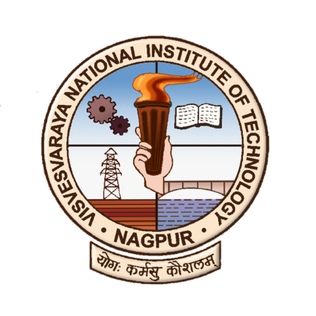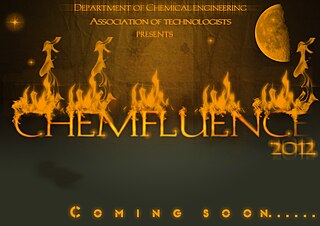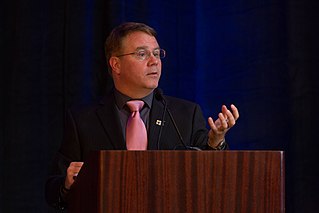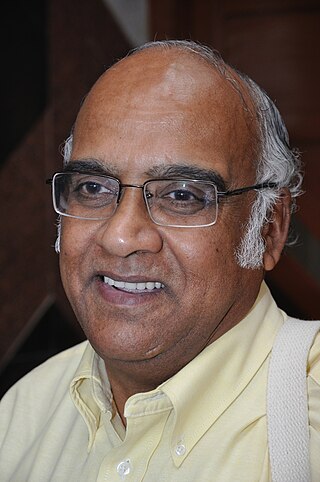
The Indian Institute of Technology Bombay is a public research university and technical institute in Powai, Mumbai, Maharashtra, India.
Green chemistry, similar to sustainable chemistry or circular chemistry, is an area of chemistry and chemical engineering focused on the design of products and processes that minimize or eliminate the use and generation of hazardous substances. While environmental chemistry focuses on the effects of polluting chemicals on nature, green chemistry focuses on the environmental impact of chemistry, including lowering consumption of nonrenewable resources and technological approaches for preventing pollution.

Visvesvaraya National Institute of Technology Nagpur (VNIT) formally known as Visvesvaraya Regional College of Engineering (VRCE) is a public technical university located in the city of Nagpur, Maharashtra. Established in 1960, the institute is among 31 National Institutes of Technology (NITs) in the country. In 2007, the institute was conferred with the status of Institute of National Importance by the National Institutes of Technology, Science Education and Research Act, 2007 of the Parliament of India with all other NITs
Ashok Jhunjhunwala is an Indian academic and innovator. He received his B.Tech. from the Indian Institute of Technology, Kanpur and PhD from the University of Maine. He has been a faculty member at the Indian Institute of Technology Madras since 1981. He is the President of IIT Madras Research Park and Chairman of International Institute of Information Technology, Hyderabad. During his career, he has contributed extensively to technology innovation and adoption in the Indian context.

Chemfluence is a national level technical symposium of the Department of Chemical Engineering, Alagappa College of Technology, Anna University, India. Started in 1994 as a college level symposium, it is now in its 29th year. Paper presentations, poster presentations, guest lectures, workshops and events form an integral part of the symposium. The symposium mainly aims at nourishing budding chemical engineers with knowledge of core concepts and providing an opportunity to showcase their talents. With more than 20 events across 3 days, it is one of the most prestigious tech events of South India. It is also one of the very few symposiums in India to host a cultural fest in association with university departments. Chemfluence is conducted annually by the Association of Chemical Engineers (ACE), the official student body of Department of Chemical Engineering, Anna University.

Paul T. Anastas is an American scientist, inventor, author, entrepreneur, professor, and public servant. He is the Director of Yale University's Center for Green Chemistry and Green Engineering, Previously he served as the Science Advisor to the United States Environmental Protection Agency as well as the Agency's Assistant Administrator for Research and Development, appointed by President Barack Obama.

Institute of Chemical Technology (ICT) is a public deemed university in Mumbai, India. The institute also has campuses at Bhubaneswar, Odisha and Jalna,. It is focused on training and research in the fields of chemical engineering, chemical technology, and pharmaceutical sciences. It was established in 1933 and was granted deemed university status in 2008, making it the only state-funded deemed university in India. On 12 February 2018 it was given the status of Category 1 institute with graded autonomy by the Ministry of Human Resource Development and the University Grants Commission (India). It is also an institute with a special status as mentioned in SECTION IV of the Report of the Empowered Expert Committee in 2018.

Jyeshtharaj Bhalchandra Joshi is an Indian chemical engineer, nuclear scientist, consultant and professor, widely known for his innovations in nuclear reactor designs and generally regarded as a respected teacher. He is the DAE-Homi Bhabha Chair Professor, Homi Bhabha National Institute, Mumbai, and is the recipient of Shantiswarup Bhatnagar Prize for Engineering Sciences and many other awards and recognitions. He received the third highest civilian honour, the Padma Bhushan, in 2014 for his services to the field of chemical engineering and nuclear science.

John Charles Warner is an American chemist, educator, and entrepreneur, best known as one of the founders of the field of green chemistry. Warner worked in industry for nearly a decade as a researcher at Polaroid Corporation, before moving to academia where he worked in various positions at University of Massachusetts Boston and Lowell. Warner is co-founder, President, and Chief Technology Officer at the Warner-Babcock Institute for Green Chemistry, as well as co-founder and President of Beyond Benign. He is the recipient of the 2014 Perkin Medal, widely acknowledged as the highest honor in American industrial chemistry.

Indian Institute of Technology Tirupati is an autonomous engineering and technology education institute located in Tirupati, Andhra Pradesh. Initially mentored by IIT Madras, now IIT Tirupati, the fastest growing 3rd generation IIT is located in Yerpedu, Tirupati, and has a size of 539 acres, including a proposed research park. The Foundation stone for IIT Tirupati was laid by the Union Minister Smriti Irani and the then Union Minister and former Vice President of India M.Venkaiah Naidu and the then chief minister of Andhra Pradesh N. Chandrababu Naidu.

Sivanandi Rajadurai aka Mylaudy Dr. S. Rajadurai is a scientist in the field of catalysis, physical chemistry, and emission control, focused on protection of the global environment and is a corporate executive. He is chairman of the Rajadurai Foundation.

Swaminathan Sivaram is an Indian polymer chemist, inventor, institution builder and a former director of the National Chemical Laboratory, Pune. He is known for his pioneering work on alkylation of tertiary alkyl halides with trialkylaluminum and olefin polymerization and holds the highest number of US patents by an Indian working outside the US. He is a fellow of several significant professional organizations. The Government of India awarded him the fourth highest civilian honour of the Padma Shri, in 2006, for his contributions to Indian science.

Ganapati Dadasaheb Yadav is an Indian chemical engineer, inventor and academic, known for his research on nanomaterials, gas absorption with chemical reaction and phase transfer catalysis. He served as the vice chancellor of the Institute of Chemical Technology, Mumbai from 2009 until November 2019. He is currently the Emeritus Professor of Eminence at ICT Mumbai.
Murali Sastry is an Indian material chemist, nanomaterial scientist and the chief executive officer of the IITB-Monash Research Academy. He is a former chief scientist at Tata Chemicals and a former senior scientist at the National Chemical Laboratory. He is known for his studies on surfaces, films and materials chemistry and is an elected fellow of Maharashtra Academy of Sciences and the Indian Academy of Sciences. The Council of Scientific and Industrial Research, the apex agency of the Government of India for scientific research, awarded him the Shanti Swarup Bhatnagar Prize for Science and Technology, one of the highest Indian science awards, in 2002, for his contributions to chemical sciences.
Devang Vipin Khakhar is an Indian chemical engineer and the former director of the Indian Institute of Technology Bombay. He is known for his pioneering researches on polymerization and is an elected fellow of all the three major Indian science academies viz. Indian Academy of Sciences, Indian National Science Academy and National Academy of Sciences, India as well as Indian National Academy of Engineering. The Council of Scientific and Industrial Research, the apex agency of the Government of India for scientific research, awarded him the Shanti Swarup Bhatnagar Prize for Science and Technology, one of the highest Indian science awards for his contributions to Engineering Sciences in 1997.

BETIC based at Indian Institute of Technology Bombay is an inter-disciplinary multi-institution initiative for medical device innovation. Established in 2014 with support from the government of Maharashtra, it comprises a network of 14 engineering and medical institutes across the state. The BETIC team have developed 50 medical devices as of 2019, and licensed 20 of them to startup companies or industry for mass production.

Sudhhasatwa Basu is an Indian chemical engineer. He is director of Council of Scientific Industrial Research - Institute of Minerals and Materials Technology (CSIR-IMMT) in Bhubaneswar, India, and is Professor of Chemical Engineering, Indian Institute of Technology (IIT) Delhi, Adjunct Professor, Institute of Chemical Technology, Mumbai and Professor of AcSIR. His research interests include electrokinetic and electrochemical phenomena in fuel cells.

Narayan Rangappa Kamath was an academic leader of the Indian Institutes of Technology (IITs) and engineering education in India, an academic administrator, chemical engineer, educator, advisor to dozens of companies, and historian of technology. He was also called NRK.
Debabrata Maiti is an Indian scientist specializing in organometallic chemistry and bioinspired catalysis and serving as Professor of Chemistry at the Indian Institute of Technology Bombay, Mumbai. He was awarded the Shanti Swarup Bhatnagar Prize, the prestigious Indian national award for excellence in scientific research, for Chemical Sciences for the year 2022 for his significant contributions to developing transition metal catalysis for transforming organic molecules to prepare value-added materials by site-selective functionalization, leading impact on agrochemicals and pharmaceuticals industry.













